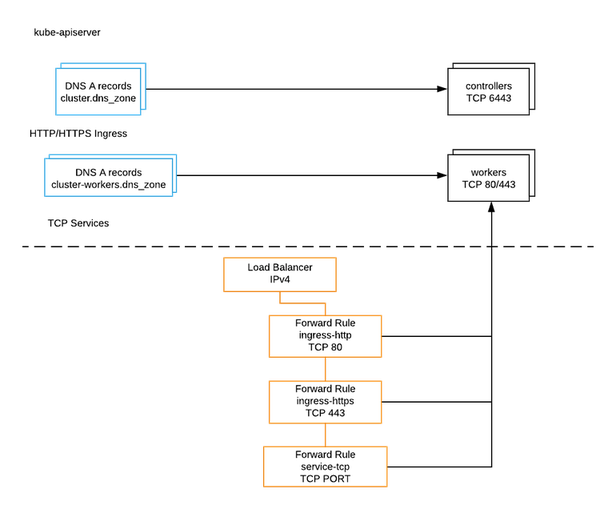DigitalOcean¶
Load Balancing¶

kube-apiserver¶
DNS A records round-robin1 resolve IPv4 TCP/6443 traffic to controller droplets (regardless of whether their kube-apiserver is healthy). Clusters with multiple controllers are supported, but round-robin means ⅓ down causes ~⅓ of apiserver requests will fail).
HTTP/HTTPS Ingress¶
DNS records (A and AAAA) round-robin1 resolve the workers_dns name (e.g. nemo-workers.example.com) to a worker droplet's IPv4 and IPv6 address. This allows running an Ingress controller Daemonset across workers (resolved regardless of whether its the controller is healthy).
The DNS record name is output as workers_dns for use in application DNS CNAME records. See Ingess on DigitalOcean.
TCP/UDP Services¶
DNS records (A and AAAA) round-robin1 resolve the workers_dns name (e.g. nemo-workers.example.com) to a worker droplet's IPv4 and IPv6 address. The DNS record name is output as workers_dns for use in application DNS CNAME records.
With round-robin as "load balancing", TCP/UDP services can be served via the same CNAME. Don't forget to add a firewall rule for the application.
Custom Load Balancer¶
Add a DigitalOcean load balancer to distribute IPv4 TCP traffic (HTTP/HTTPS Ingress or TCP service) across worker droplets (tagged with worker_tag) with a healthy Ingress controller. A load balancer adds cost, but adds redundancy against worker failures (closer to Typhoon clusters on other platforms).
resource "digitalocean_loadbalancer" "ingress" {
name = "ingress"
region = "fra1"
vpc_uuid = module.nemo.vpc_id
droplet_tag = module.nemo.worker_tag
healthcheck {
protocol = "http"
port = "10254"
path = "/healthz"
healthy_threshold = 2
}
forwarding_rule {
entry_protocol = "tcp"
entry_port = 80
target_protocol = "tcp"
target_port = 80
}
forwarding_rule {
entry_protocol = "tcp"
entry_port = 443
target_protocol = "tcp"
target_port = 443
}
forwarding_rule {
entry_protocol = "tcp"
entry_port = 3333
target_protocol = "tcp"
target_port = 30300
}
}
Define DNS A records to digitalocean_loadbalancer.ingress.ip instead of CNAMEs.
Firewalls¶
Add firewall rules matching worker droplets with worker_tag.
resource "digitalocean_firewall" "some-app" {
name = "some-app"
tags = [module.nemo.worker_tag]
inbound_rule {
protocol = "tcp"
port_range = "30300"
source_addresses = ["0.0.0.0/0"]
}
}
IPv6¶
DigitalOcean load balancers do not have an IPv6 address. Resolving individual droplets' IPv6 addresses and using an Ingress controller with hostNetwork: true is a possible way to serve IPv6 traffic, if one must.
| IPv6 Feature | Supported |
|---|---|
| Node IPv6 address | Yes |
| Node Outbound IPv6 | Yes |
| Kubernetes Ingress IPv6 | Possible |